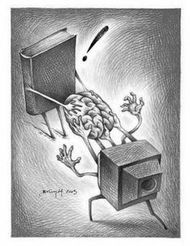|
by Brianna McCray
0 Comments
 by Laura Kincaid I watch cartoons. I’m not talking about Family Guy or Rick and Morty, but cartoons created for and targeted at children. I’m not alone. Shows like Steven Universe, Adventure Time, and Avatar: The Last Airbender have garnered huge audiences from kids to teens to twenty-somethings and older. Countless blogs and video essays propose a pile of reasons why cartoons are suddenly “not just for kids anymore” like how they relieve stress, produce a sense of nostalgia, or provide life lessons useful to everyone. But when people ask me why I watch cartoons, I answer: “For the writing.”  image credit: Pinterest image credit: Pinterest by Nicolina Givin I sat on my couch on the fourth of October and flipped through the channels on my television. I caught a glimpse of Emily Blunt grabbing a blonde by the back of her head and dragging her onto the floor. The title, The Girl on the Train, flashed at the end and I was in bewilderment. “That’s a movie now?” I thought to myself. The movie was released to theaters on the eighth. I picked up the novel, which had been sitting on my bookshelf for some time, and opened the cover, ready to finally read what everyone was about to see on the big screen. I could not have the world tell me the plot and ending before I could figure it out myself; I had to finish it before the movie release. Why was I motivated soon after that preview to read the book rather than when I first purchased that book eight months prior? The answer was always sitting there on my bookshelf, but the media pushed me towards it and spoke clearer to me in that thirty-second preview. by John Gross
Throughout time technology has changed how the writer crafts his novel. From pen and paper, to typewriters, to word processing—the tools of the trade are constantly evolving. In today’s world, the writer can craft a sentence and move it around to different places, supplementing paragraphs where he sees fit. This can be a powerful tool, that makes the revision process more fluid and dynamic. An author can be less committed to putting something on a page, where it can be easily reshaped, moved, and removed. While this technology has fundamentally changed how the novelist crafts his work, it hasn’t really changed how the reader consumes it. Sure, we are in a period of time that is showing the rise of e-readers and digital print, but ultimately the novel is being experienced in the same traditional way. |
Archives
July 2024
Categories
All
|
|
Glassworks is a publication of Rowan University's Master of Arts in Writing 260 Victoria Street • Glassboro, New Jersey 08028 [email protected] |
All Content on this Site (c) 2024 Glassworks
|


 RSS Feed
RSS Feed
